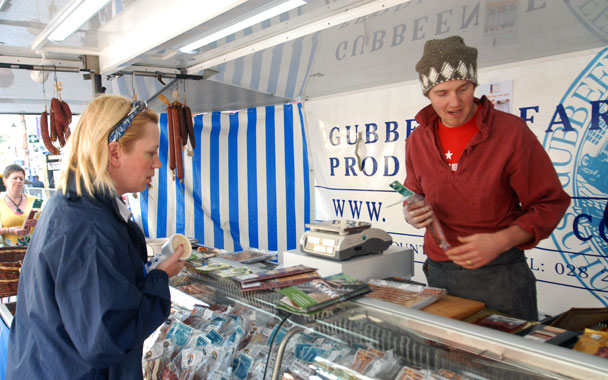The sky is temporarily blue on the Sunday of an otherwise rainy early September weekend in Ireland’s “sunny South East,” and I’m wandering through a sprawling farmers and producers market in John Roberts Square, in the world-renowned glass-making capital of Waterford. Many of the stars (and cult heroes) of Ireland’s vigorous artisanal-food movement are here, generously dispensing their wares, and I figure it would be churlish of me not to indulge myself in as many of them as possible. I start with slivers of Giana Ferguson’s emblematic Gubbeen cheese and a few rounds of one of her son Fingal’s Mediterranean-Irish salamis, and stick a packet of his mica-thin West Cork guanciale into my bag, wondering if I should try to finesse it past customs when I fly back to the States. I taste the smoked version of Jane Murphy’s assertive goat cheese (I believe it’s my first-ever smoked chèvre, and it captivates me). At sausage-maker Jane Russell’s stand, I buy one of her plump, juicy Irish pork sausages, served with homemade relish (“It’s a little fiery,” she warns; “There’s some jalapeño in there”) on a hot-dog-bun-shaped version of the city’s famous Waterford blaa, a soft, flour-coated roll. Richard Auler shares a bit of one of his organic dry-aged Angus burgers (his sign reads “Orgasmic,” with the “sm” lightly crossed out and an “n” put in). I try more cheeses, then drift over to American-born Cate McCarthy’s Cookie Jar stand for one of her oversize chocolate chip masterpieces.
This is the third and last day of Terra Madre Ireland, held on the campuses of Waterford Institute of Technology and around the town itself. Under the aegis of Slow Food, Terra Madre (literally “Mother Earth”) is a four-year-old international network of sustainable food communities, encompassing everyone from raisin producers in Afghanistan to tea producers in Zimbabwe. Their first-ever Irish meeting has drawn more than a thousand participants, food professionals and otherwise, from all over the island and beyond. Slow Food founder Carlo Petrini has come over from Italy to address the group; the irrepressible Darina Allen of the Ballymaloe Cooking School in East Cork—whom it would be facile but not inaccurate to call the Irish Alice Waters—is everywhere in her capacity as Slow Food Ireland chairperson. There’s even an address by Mary McAleese, the president of Ireland—who once took classes at Ballymaloe and who revealed that she keeps a vegetable garden and a chicken coop on the grounds of the Áras an Uachtaráin (the Irish version of the White House).
The market was great fun, but the serious business of the weekend had come on Friday, when farmers, food producers, fishermen, restaurateurs, hoteliers, journalists, cooking teachers, and other food folk—among them Good Food Ireland founder Margaret Jeffares; GFI mainstay and Waterford hotelier Maurice Keller; “artisanal grocer” (my term, not his) Peter Ward; artisan baker Robert Ditty from Castledawson in Northern Ireland; Belfast restaurant pioneer Nick Price; food writer and TV personality Clodagh McKenna; maverick West Cork sausage-maker Frank Krawczyk; and Kay Harte, who runs the superlative Farmgate Café in Cork City’s English Market—filled WIT classrooms to participate in almost 40 workshops. The topics included everything from beef, pork, fish, and fruit to marine resources, food tourism, and food law. Each workshop produced a wish list of recommendations to be presented later in the day to Irish food minister Trevor Sargent and Northern Ireland’s minister for agriculture and rural affairs, Michelle Gildernew. One theme repeated often and in different ways was that there needed to be more stringent standards for place-of-origin labeling.
That night, we all repaired to WIT’s College Road campus for a barbecue of organic pork, sausages, and remarkable baby lamb overseen by Michael Quinn, chef at Waterford Castle. There was great bread and ample wine on the tables, along with big bowls of straight-from-the-garden salad greens and (of course) potatoes. It was a glowing evening—though I did feel a slight chill when somebody mentioned that the decommissioned church in which we were dining had been the chapel for one of Ireland’s infamous “Magdelene laundries,” to which errant young Irish women were exiled and virtually enslaved until well into the late 20th century.
The only other false note of the weekend had come on Friday, when workshop participants filed into the WIT cafeteria for a buffet lunch—only to find a repast of tired, cold seafood (including mushy poached salmon that was an insult to this noble fish) and steam-table Irish stew, generic pork loin with cabbage, and anonymous vegetables (with no bread, no wine). That this meal could have been served to this gathering was as vivid an illustration as I can imagine of just how far—despite Ireland’s fine chefs, agricultural bounty, artisanal riches, and great overall gastronomic potential—Irish food culture still has to go.



 Pinterest
Pinterest


